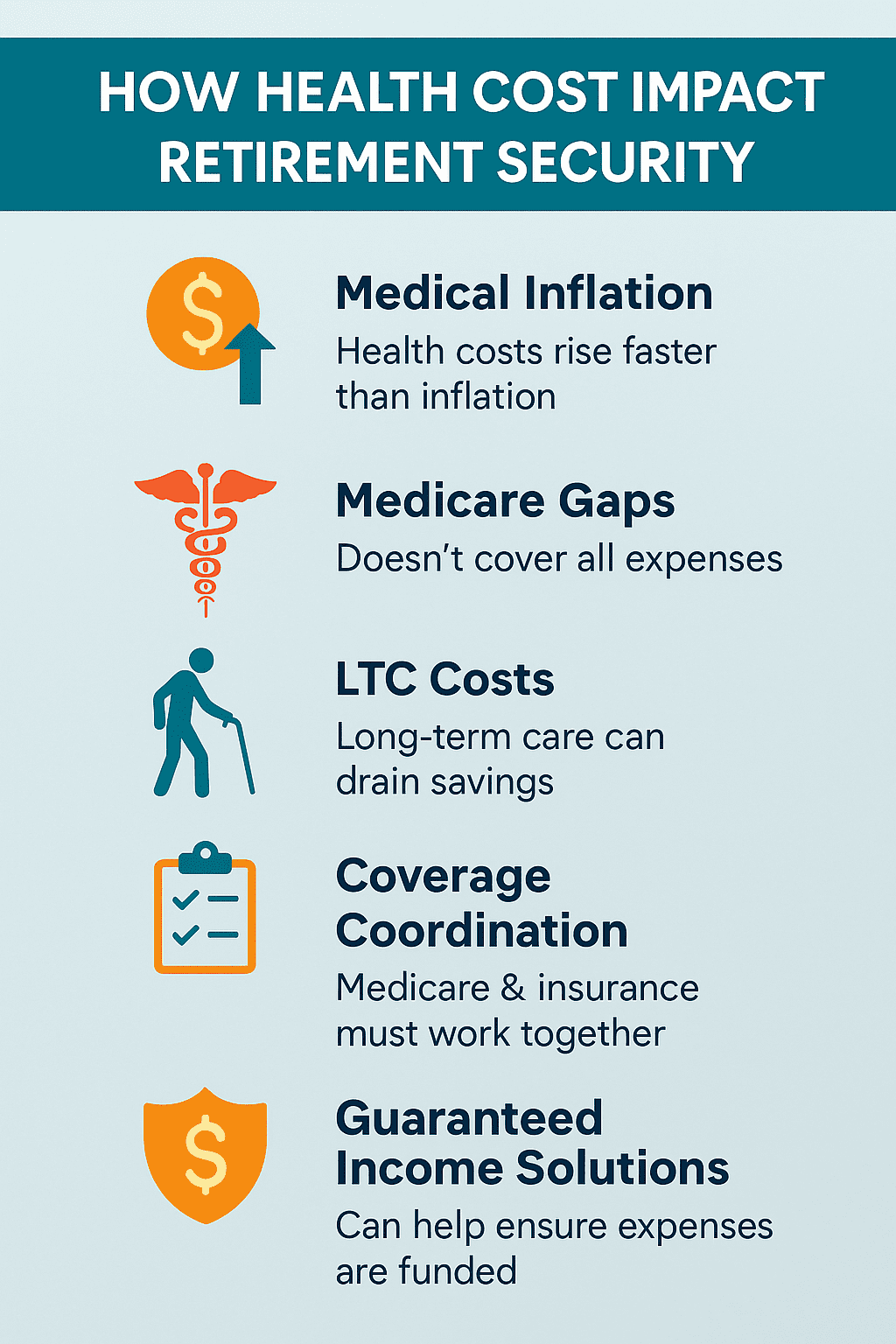The Hidden Link Between Health Costs and Retirement Security

Why Health and Wealth Are More Connected Than Ever
When planning for retirement, most people focus on saving enough money to live comfortably. But there’s one expense that catches many retirees off guard — healthcare.
As people live longer, healthcare becomes one of the largest and most unpredictable retirement costs. And without careful planning, medical expenses can quietly drain even the best-built nest egg.
This Financial Planning Awareness Month, it’s time to connect the dots between your healthcare strategy and your retirement income plan.
The Real Cost of Healthcare in Retirement
A recent national estimate suggests that the average 65-year-old couple retiring this year may need over $315,000 to cover healthcare expenses throughout retirement — and that doesn’t include long-term care.
While Medicare helps, it doesn’t cover everything. Retirees can still face costs like:
- Premiums for Parts B, D, and Medigap or Medicare Advantage
- Deductibles and copays for doctor visits and hospital stays
- Dental, vision, and hearing care, which Original Medicare does not cover
- Prescription drugs not fully covered by Part D
- Long-term care services such as assisted living or in-home help
Without a coordinated plan, these costs can easily eat into your retirement income — or force you to withdraw more from savings during market downturns.
Why Healthcare Inflation Hits Retirees Hard
Healthcare inflation consistently outpaces general inflation. Even modest annual increases can have a compounding effect over 20 to 30 years of retirement.
Example:
If medical costs rise by just 5% per year, expenses that start at $6,000 annually can balloon to more than $16,000 after 25 years.
That means the dollars you set aside today may not stretch as far tomorrow — especially without income sources that rise with inflation.
The Hidden Retirement Risk: Long-Term Care
Long-term care (LTC) is often the elephant in the room when it comes to retirement planning. Seven out of ten retirees will need some form of long-term care in their lifetime — yet few plan for it.
Average LTC Costs in 2026:
- In-home care: $5,000 per month
- Assisted living: $5,500 per month
- Private nursing home: $10,000+ per month
Those costs can quickly deplete savings, but there are ways to prepare.

Options to Protect Against LTC Costs:
- Annuities with long-term care riders: Provide enhanced income if you require care, while continuing to grow your money if you don’t.
- Hybrid life insurance policies: Combine life insurance with living benefits for tax-free long-term care funding.
- Traditional LTC insurance: Pay annual premiums in exchange for daily or monthly care benefits.
The right choice depends on your age, health, and financial situation — but acting early locks in more options and lower costs.
Building a Health-Inclusive Income Plan
An effective retirement plan treats healthcare as a core expense, not an afterthought.
Here’s how to integrate it into your broader income strategy:
| Step | Action | Why It Matters |
|---|---|---|
| 1 | Estimate your annual and lifetime health costs | Understand the true impact on your retirement income |
| 2 | Coordinate Medicare and supplemental coverage | Avoid coverage gaps and surprise bills |
| 3 | Create guaranteed income for essentials | Annuities can help ensure medical costs are always funded |
| 4 | Protect savings from market risk | Fixed indexed annuities grow safely and protect principal |
| 5 | Review annually | Health, laws, and plan options change — your plan should too |
The Role of Safe Income Solutions
Healthcare expenses can fluctuate — your income shouldn’t. That’s why many retirees are turning to guaranteed income strategies, like annuities, to cover recurring medical costs.
These income streams act like a personal pension, giving you predictable monthly payments that help fund healthcare, insurance premiums, and daily living expenses — even during market downturns.
Pairing guaranteed income with Medicare and insurance coverage helps ensure you can weather both medical and financial storms with confidence.
Don’t Wait for a Health Event to Start Planning
The best time to plan for healthcare costs is before you need them. Waiting until a health event occurs can limit your choices and increase costs.
This Financial Planning Awareness Month, take time to:
✅ Review your current Medicare or insurance coverage.
✅ Calculate potential health and long-term care expenses.
✅ Explore how guaranteed income could strengthen your financial security.
Final Thoughts
Healthcare planning is financial planning. The two can’t be separated if your goal is long-term stability and peace of mind.
By accounting for health costs in your income strategy today, you’re not just protecting your savings — you’re protecting your independence and your quality of life.
Because true retirement security isn’t just about money—it’s about living well for as long as possible.
Written by Brent Meyer, founder of SafeMoney.com. With more than 20 years of experience helping families navigate retirement and legacy planning, Brent is committed to making financial education simple, clear, and trustworthy.
Disclaimer
This article is for educational and informational purposes only and does not constitute medical, legal, or financial advice. Please consult licensed professionals regarding your specific situation. SafeMoney.com is not affiliated with or endorsed by any government
agency.








